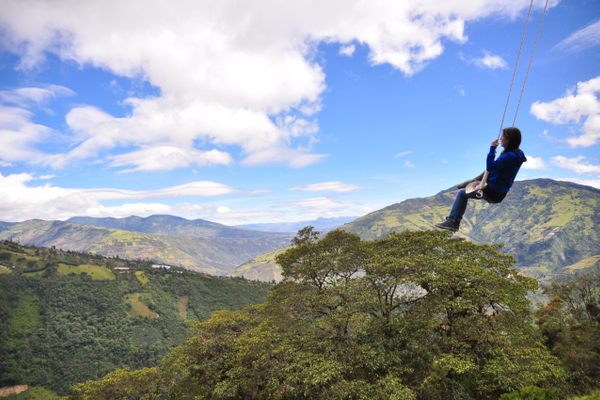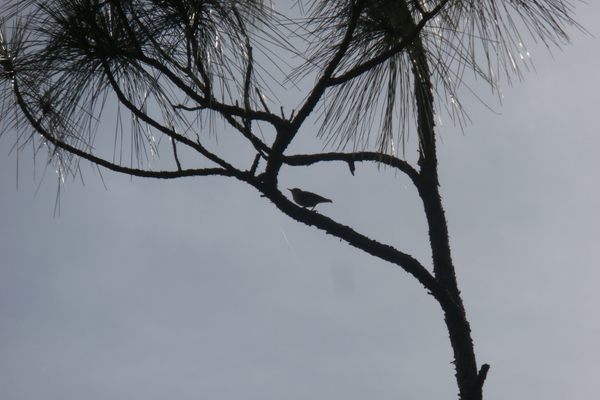The Existential Ennui of Discovering an Endangered Species
Newly found and already almost lost.

It all started in April 2017, when Francisco Sornoza-Molina, an ornithologist at the National Institute for Biodiversity in Quito, Ecuador, was wandering the alpine plateaus (called “paramos”) of Cerro de Arcos, a rock formation in the country’s southwestern region. He was on the lookout for hummingbirds.
The paramos are belts between forest and snow line, where the landscape is cold and nearly treeless. Wind whips across tufts of tussock grasses and clusters of cushion plants, flat as emerald mats. Rabbits and foxes roam among the flowering shrubs, and rodents do their best to dodge caracaras—birds of prey with an appetite for all things small and furry. Despite the wind and low temperature, there are a lot of hummingbirds in this part of the Andes, too.
Sornoza-Molina spotted a bird, except it didn’t look quite like he thought it would. He snapped a photo, thinking it was probably an immature hillstar hummingbird, but male hillstars have brilliant violet or green plumage spangling their throats, while this one wore a deep, royal blue. Sornoza-Molina left, but soon trekked back to stands of Chuquiraga jussieui to get a closer look (hummingbirds often drop by to enjoy nectar from the orange and yellow flowers). Researchers then headed to areas nearby to collect sound recordings, install a camera to capture behavioral data, and eventually nab some specimens.

Genetic testing and vocal analysis confirmed what Sornoza-Molina had begun to suspect. He had a new species on his hands. He and a group of collaborators dubbed the bird Oreotrochilus cyanolaemus, or the blue-throated hillstar. But just as soon as they’d identified it, they realized the bird’s days might be numbered.
Researchers only spotted individuals in five places. When they modeled the species’ possible range, even the most optimistic estimate spanned barely 62 square miles. As they describe in a new paper in The Auk: Ornithological Advances, the grass and bush habitats the bird seems to prefer are increasingly grazed by livestock, transformed into cropland, eaten up by fire, or reserved for gold mining. The authors estimate that the species probably numbers no more than 750 individuals, and maybe as few as 250.
“It’s very scary,” says Elisa Bonaccorso, a study coauthor and ecologist at the University of San Francisco, in Quito. “My fear is that, anything that’s new that’s there, we’re going to lose it before we describe it.” In certain circumstances, she says, conservationists could band together, raise money, and buy up land to save the habitat. But that’s not an option here, she says, where the land is “so valuable for mining that owners wouldn’t sell.” So the researchers found themselves with a conservation challenge—and an existential one.

In the montane forests of Africa’s Albertine Rift, which stretches more than 620 miles from Democratic Republic of the Congo down to Zambia, another recently recorded bird is facing a similar struggle. This landscape is home to a full 50 percent of the continent’s bird species, including many that aren’t found anywhere else. One of these is Willard’s sooty boubou (Laniarius willardi), an ink-colored bird first described a few years ago. Using a hybrid of museum sources, fieldwork, and remote-sensing data, researchers recently estimated that the bird’s range is limited, and probably contracting all the time. “Niche modeling combined with data layers on current land use and forest cover confirm that few areas outside of designated [protected areas] have suitable habitat for L. willardi,” a team of ecologists write in a recent paper in The Condor: Ornithological Applications.
This scenario has played out before, sometimes with expectedly grim results. In the late 1970s, biologists from Rio de Janeiro revisited Brazil’s northeastern region, where European colonizers had obliterated the lowland forest in favor of agriculture and cities. The researchers came across a handful of isolated ecosystems that seemed fairly unscathed, explains Tom Schulenberg, an evolutionary biologist at the Cornell Lab of Ornithology. On some hilltops, they found tiny patches of forest—wild islands in a sea of sugarcane. “To everyone’s surprise, [they] discovered several previously unknown species,” writes Schulenberg in an email. One of these was the Alagoas foliage-gleaner. The rust-colored passerine bird was first spotted in 1979, then described in 1983, and there’s been no trace of it for at least seven years. In a recent paper in the journal Biological Conservation, a team from BirdLife International recommended classifying it as extinct.
Is it possible to keep blue-throated hillstar and Willard’s sooty bouboun from the same fate? How do you get people interested in saving a newly recorded species, before most have even heard of it? Gorillas, elephants, and other iconic animals are a comparatively easy sell. It’s harder to convince someone who has never seen one of these birds that they’re worth saving, especially when doing so could impact the local economy.
Bonaccorso’s team proposed that one way to save the species (and its ecosystem) is enticing people to come seek it out, which could provide reliable income to local people. Ecologists, she says, have to try something besides arguing for the intrinsic value of protecting nature. “[It is] not about how beautiful the bird is, but how we can use this bird to have an income.” The researchers are beginning to explore how ecotourism initiatives could bring birdwatchers to the area, and how locals can benefit from their interest.

Across the Albertine Rift, the key might be doubling down on sections of the sooty boubou’s habitat that are already theoretically protected, says Fabio Berzaghi, a data scientist and lead author of the paper in The Condor. That approach depends on the strength of enforcement. “If an area has been assigned a protected-area status, it’s basically not even useful if you don’t do any enforcement or protection,” says Berzaghi, who conducted the work at the University of Tuscia, in Italy. In any event, he adds, it’s easier to devise strategies for this than it is to convert land designated for crops or communities back to a wilder state.
Meanwhile, this extinction quandary is also motivating some researchers to look more closely at sensitive habitats. The team in Ecuador wasn’t expecting to find new species where they did, Bonaccorso says, but then again, they weren’t always looking for them. Research institutions tend to be concentrated in Quito, not in this region, more than 370 miles away. There’s sometimes a perception that “because there’s so much development already, everything is lost,” she adds. Bonaccorso considers the discovery a “wake-up call,” and a reminder that the landscape still has the capacity to surprise. “There could be some remaining forest or paramos that we haven’t studied, surrounded by destroyed ecosystems,” she says. “I think we have to try our best.”

















Follow us on Twitter to get the latest on the world's hidden wonders.
Like us on Facebook to get the latest on the world's hidden wonders.
Follow us on Twitter Like us on Facebook